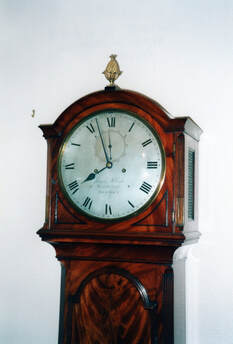|
In my November blog I attempted to show some of the problems facing prospective buyers of early 18th century clocks. Following on from that theme I would like to look at clocks made after about 1730. After Humphrey Maysmore’s death in 1706 his widow Mary turned their son Humphrey over to Richard Vick in the C.C. who had been trained by Daniel Quare. Humphrey junior would have completed his apprenticeship by about 1714 and by 1717 he was working in Wrexham. An interesting example of Humphrey Maysmore junior’s clocks (Fig. 1) is housed in the Wrexham Museum. The dial of the clock shows a remarkable resemblance to features shown on some of Daniel Quare’s clocks.  Figure 1: 8-day arched dial clock by Humphrey Maysmore Junio c.1730 - 40 Figure 1: 8-day arched dial clock by Humphrey Maysmore Junio c.1730 - 40 The 8-day arched dial clock made c.1730-40, in a mahogany case, is nicely engraved. The date ring in the arch has a matted centre and is flanked by dolphin pattern spandrels. The subsidiary dials below the arch are similar to those on Quare clocks, with strike/silent dial on the left and regulating dial on the right, both with engraved centres. The corner spandrels are the male mask design. Inside the chapter ring is a seconds dial at the top and below centre there is a day of the week aperture with the astrological symbols in the roundel below representing the different times of the year. The winding holes have turned engraving around them. The chapter ring shows half-quarters in the outer minute numbering band and fine half-hour markers in the hour ring. Moving on to our next clock which is an 8-day arched dial clock by Thomas Gardener of London c.1740 (Fig.3) housed in a beautiful figured walnut case.
John Greaves of Newcastle was working from about 1745 until his death in 1794; he was quite a prolific maker but his clock in (fig 4) is rather unusual.
Our next clock is a fine example of engraving by the Beilby and Bewick workshop and has a disc in the arch with the date 1765 engraved on it.
Some single sheet arched dials were used in London from c.1760-1800 but a number of round dials were also introduced in the Capital at that time. An interesting example of a round dial is illustrated in Fig. 6 which has an 8-day round dial by James McCabe, Royal Exchange, London, made about 1780.
By 1780 painted dials were more popular in the provinces but a few single sheet silvered brass dials were used at the end of the century. One example of a single sheet brass dial (Fig.7) is by John Liddell of Morpeth and was made c. 1790-1800.
Most of the provincial clocks produced from c.1780 had painted dials but London dials remained in brass single-sheet or with solid chapter ring into the 19th century. After 1800 most, if not all provincial dials were painted ones.
If you would like some orientation regarding dating an antique clock, feel free to get in touch with me here. If you would like to read more about Antique clock and watchmakers, perhaps you would be interested in my new book, Early clock and watchmakers in the Blacksmiths' Company.
0 Comments
|
AuthorKeith Bates is an amateur horologist who has been researching clocks, watches and chronometers and their makers for over 30 years. Archives
August 2023
Categories
All
|







 RSS Feed
RSS Feed